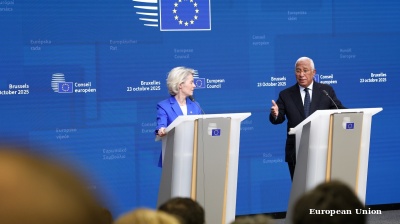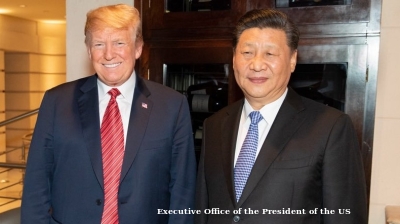After a disappointing slowdown this year, Hungarian GDP growth is expected to pick up in 2017 to 4.1% y/y, the updated growth and fiscal forecast of the country’s economy ministry showed on December 20.
The optimistic forecast reflects hopes that a massive stimulus package passed earlier this month will support strong private consumption and boost investments. At the same time, the ruling Fidesz party likely expects that the measures will cheer up the growing number of dissatisfied voters ahead of the 2018 elections.
Revising downwards its original full-year growth projection of 2.5%, the cabinet expects that – mainly reflecting a lull in EU-funded projects this year - real GDP growth in Hungary will ease to 2.1% this year from 2.9% in 2016.
At the same time, Budapest also insists that "thanks partly" to the government’s recent agreement with employers about the rejig of the country’s tax and wages structure, the Hungarian economy will grow at an impressive rate next year. "The deal is to substantially influence the macro-economic outlook of coming years and place the Hungarian economy on a faster growth path,” the government claims.
The government will hike the minimum wage by 15% in 2017, and a further 8% in 2018; social contributions will drop 5pp to 22% and to 20% in 2018. Budapest will also lower the corporate tax rate to 9%, which will be the lowest in the EU.
The announcement of the fiscal stimulus package has also led many analysts to revise upwards their GDP growth projection, to exceed 3% in 2017. “Even though the 4.1% annual GDP growth forecast by the EconMin is not out of reach for next year, a very positive outcome is needed for that,” analysts of Erste wrote in a note, who plot a 3.4% GDP growth next year. RBI forecasts a 3.2% expansion, while OTP suggests that growth may approach 4% next year.
Tight labour market conditions together with increases in real wages suggest that household consumption will remain the main engine of economic growth next year. While the consumption expenditures of households slowed to 4.5% in Q3 from 5.2% in the previous quarter, the growth still shows a robust pace and is expected to accelerate in 2017, supported by the government’s measures.
"The 15% minimum wage increase and 25% guaranteed wage increase for skilled labour is quite significant,” Gunter Deuber and Zoltan Torok, analysts at RBI told bne IntellInews, adding that workers in education, health care and public administration are also expected to earn more next year. The analysts also forecast that the reduction of employers’ social security contribution will be “passed on” to employees in the majority of cases “given the general scarcity of labour and the already existing wage pressures”.
According to GKI surveys, businesses employing over 250 persons had planned to lift wages by 11% and SMEs by a rate between 6.5% and 8.2% before the announcement of the mandatory wage hikes. This highlights the fact that while raising the minimum wage will not cause a problem for large companies, “small firms will suffer severe competitiveness problems forcing them to layoffs and making their activities grey”, GKI notes.
The acceleration of GDP growth will also be driven by the recovery in investment due to the ramp up of the new EU fund cycle. “In 2016 the contraction of investments is more pronounced than we anticipated, mainly explained by the temporary fall out of EU funds inflow. In 2017 the turnaround will be similarly more pronounced,” Deuber and Torok forecast.
While the public sector continued to see a plunge in investment on an annual basis in Q3, corporate investment already showed signs of revival. Budapest hopes that the construction sector “will receive significant contribution from the expected boom” in the government's housing subsidy programme. Meanwhile, big-ticket investments such as Samsung’s and Mercedes-Benz’s plant extensions - hitting a combined €1.3bn - may lead to double-digit growth in gross capital formation in 2017, according to OTP.
Deuber and Torok forecast that manufacturing output will also increase next year. “In 2016 we have seen a rollercoaster performance predominantly driven by car industry output volatility (…) however, there are new capacities coming into operation starting from 2017 onwards, so we expect stronger manufacturing output growth in 2017,” they note to bne IntelliNews.
The government also expects that the huge cut to the corporate tax rate will boost Hungary's competitiveness and FDI inflow. However, the fact that other business costs remain elevated and the country struggles with a serious shortage of skilled labour, raises concerns over those hopes. Critics also fear that the tax cuts will add to pressure on the budget, reducing the possibility of spending on structural reforms and improving education, or even on basic social services and healthcare.
The government nevertheless insists that the strong 2016 budget performance leaves room for manoeuvre. The lowering of the corporate tax will result in a HUF145bn (€461mn) loss of revenues in 2017 and HUF100bn in 2018, according to the economy ministry’s estimate sent to Portfolio.hu. The contribution cut is expected to cost the budget HUF380bn in 2017 and HUF540bn in 2018. At the same time, the ministry expects that the costs will eventually be neutralised by higher tax revenues not only from the increased minimum wage but also from salaries higher up the wage scale.
“The minimum wage hike and the contribution cut together will have practically no effect on the general government balance in 2017,” Economy Minister Mihaly Varga insisted. While the ministry had earlier suggested that the general government deficit is likely to finish at 1.7% of GDP in 2016, it hiked the deficit projection to 2.3% on December 20. Next year’s fiscal plan targets a deficit of 2.4%, which suggests that the cabinet will continue spending.
Eyes are clearly on the upcoming 2018 elections as the government is putting more money into voter’s pockets. While the right-wing Fidesz party continues to comfortably lead the polls ahead of a fragmented opposition, a recent research carried out by Zavecz Research and Policy Solutions shows that in October-November 61% of the electorate thought that Hungary is heading in the wrong direction. The most dissatisfied ones are pensioners, the least educated people and those living on the countryside. The government likely hopes that the minimum wage hike, together with a HUF10,000 bonus handed out to each pensioner ahead of Christmas, will help to quickly cheer up disillusioned voters.
While the general elections in April 2018 might seem to be far away, Fidesz already announced that it will launch a new billboard campaign. It will inform – and remind – citizens about recent reforms including wage increases and tax cuts, and will also point out the improvements of the Hungarian economy.
“Hungary is strengthening (…) The government’s goal is for everyone to feel the country’s strengthening in their own lives as well,” the government insists on its recently launched campaign website.
News
_1761305900.jpg)
Latin America edges up growth forecasts but remains trapped in low gear, ECLAC says
Latin America and the Caribbean will expand 2.4% this year, the Economic Commission for Latin America and the Caribbean said, marking the second upward revision since April but pointing to the region's struggle to escape chronically weak growth.

Palestinian ambassador pledges Iraqi embassy in Jerusalem
Palestinian ambassador pledges to open Iraqi embassy in Jerusalem as Iraq lays foundation stone for Palestinian ambassador's residence in Baghdad's new diplomatic quarter covering 300 hectares.

EU pledges ongoing support for Ukraine, defers decision on Russian assets
European Union leaders pledged continued financial backing for Ukraine over the next two years, but delayed a decision on tapping billions of euros in frozen Russian assets to fund Kyiv’s defence

Trump Administration striving to strike critical minerals deal with Kazakhstan
Pushing for US firm to win rights to develop major tungsten deposits.




